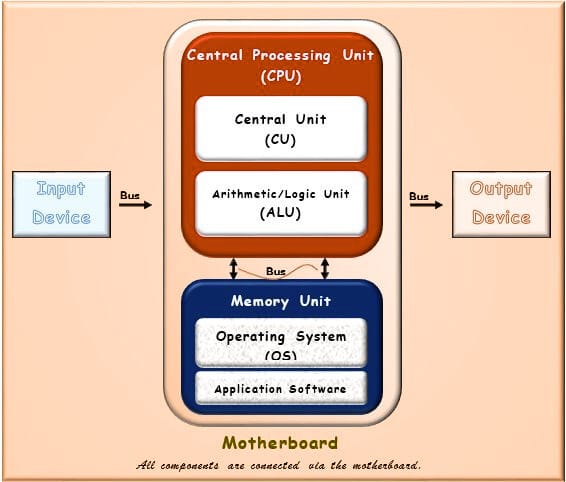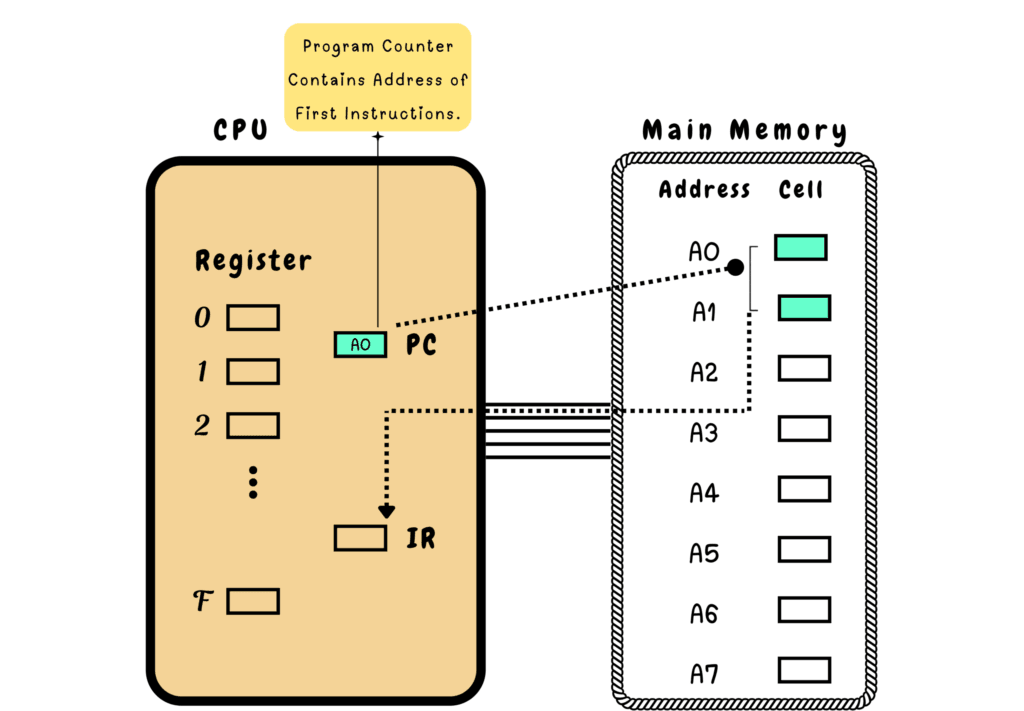Von Neumann Architecture of a computer system, its 4 main components, function, and working are discussed here.
Table of Contents
Introduction
Have you ever wondered what happens when you type something on a keyboard or run a program?
We use computers every day, but most of us do not know how they work on the inside. What makes letters appear on the screen? How does a machine understand what to do?
Here, we shall explain how a computer works — step by step — in a simple and fun way. To help you make sense of it all, a short story about writing a word, Apricot, will be discussed.
Von Neumann Computer Architecture
The Von Neumann architecture is a foundational computer model proposed by John von Neumann in the 1940s.
It defines a system with 4 main components that work together to process data and execute instructions.
4 Components of Von Neumann Architecture

1. Memory Unit
The memory unit stores both data and program instructions temporarily for quick access during processing.
For example, RAM holds a running application, its current progress and data for fast access.
2. Central Processing Unit (CPU)
The CPU executes instructions and performs all arithmetic and logical operations. There are two main parts:
- Arithmetic Logic Unit (ALU): Performs arithmetic and logical operations.
- Control Unit (CU): Directs operations within the CPU and coordinates other components.
3. Input/Output (I/O) Devices
Input devices allow users to enter data and commands into the computer system. For instance, a keyboard is used to type text into a document.
Output devices display or present the results of computer processes to the user. A monitor, for example, shows the results of a spreadsheet calculation.
4. System Bus
The system bus enables communication between the CPU, memory, and other components. It includes:
- Data Bus: for transferring data—like moving a number from memory to the CPU for processing.
- Address Bus: for specifying locations—like identifying the memory address where a file is stored.
- Control Bus: for sending operation signals—like a CPU retrieving data from a specific memory location.
Instruction Cycle (Working)
The CPU executes instructions in the following sequence:
1. Fetch
- Firstly, program Counter (PC) holds the address of the next instruction.
- This instruction is fetched from memory into the Instruction Register (IR).
2. Decode
- The Control Unit (CU) decodes the instruction (identifies the operation).
- The decoding takes place at instruction register (IR).
3. Execute
- In the execution phase, ALU performs the required computation.
- CU handles any data movement or control tasks while ALU is computing. It also handles non-ALU operations.
4. Store
- Results are sent back to memory or an output device for display.

Example
When you calculate 2 + 2:
- ALU performs the addition.
- CU ensures each step happens in the correct order.
3 Characteristics of Von Neumann Architecture

1. Single Memory Store
Both data and instructions share the same memory.
For example, in a game, the game code and player score are stored in the same RAM.
2. Sequential Execution
Instructions are executed one at a time, in order.
For instance, a computer runs a program and follows the steps in the written order (credited to the programmer).
3. Stored Program Concept
Programs are stored in memory and can be updated or changed.
For instance, updating software replaces the program instructions in memory.
Advantages and Disadvantages
| Advantages | Disadvantages |
| Simplified Design One memory for both data and instructions reduces complexity. | Von Neumann Bottleneck The single memory bus slows down processing when both data and instructions compete for access. |
| Flexibility Programs can be changed just by altering memory contents. | Security Risks Shared memory for instructions and data can lead to vulnerabilities, where one program could unintentionally or maliciously alter instructions of another. |
How a Computer Writes “Apricot”
To understand how a computer system works, following the Von Neumann Architecture, let us imagine a scenario where we want to display the word “Apricot” on the screen. It might seem simple, but inside the computer, an outbreak of tiny, rapid steps are taking place.

You tell the computer:
“Please show the word Apricot on the screen.”
The computer gets to work, and a helpful component called the Program Counter (PC) steps forward and says: “Let me find the first instruction.”
It then looks inside the memory of the computer, like checking a locker, and retrieves the instruction:
“Show the letter A.”
This instruction is then handed over to another helper, the Instruction Register (IR). The manager, the Control Unit (CU), examines the instruction and declares:
“I understand! We need to show the letter A.”
Then, the Control Unit turns to one of its efficient associates, a general-purpose register, and instructs:
“Hey, hold onto this letter ‘A’ for a moment! Think of me as a quick-access sticky note for the computer.”
Since computers use 0s and 1s to represent everything, the letter ‘A’ is temporarily stored in this register as a binary code. So, the register would hold something like:
01000001 (the binary representation for ‘A’)
Next, it is time to display the letter. The computer sends that binary number to the Output System, which interprets it and says:
“This means the letter ‘A’. Let’s draw it on the screen!”
And just like that, the letter ‘A’ appears.
The same sequence of events unfolds for the remaining letters: ‘p’, ‘r’, ‘i’, ‘c’, ‘o’, and ‘t’. – one at a time. Finally, the word ‘Apricot’ fully appears on your screen, thanks to the seamless teamwork of these different parts inside the computer.
Conclusion
The Von Neumann architecture is a foundational model for modern computers. While it has limitations, especially around performance and security, it remains the basis for most computing systems today, shaping the way machines store and process data.
Frequently Asked Questions (FAQs)
Which thing best describes the Von Neumann architecture’s main characteristic?
The main characteristic of the Von Neumann architecture is that data and instructions are stored in the same memory and accessed via the same bus system. This allows the CPU to fetch instructions and data from the same memory space.
What is a disadvantage of the Von Neumann architecture?
Von Neumann bottleneck slows processing due to a shared memory bus for data and instructions. The shared memory also poses security risks from potential instruction/data tampering.
What transports data inside a computer among different components?
The Bus is the pathway that transports data, instructions, and control signals among different components of the computer, such as the CPU, memory, and input/output devices.
What is the Von Neumann architecture of a computer? List its key components.
Von Neumann computer architecture is a system design where:
- Program instructions and data are stored in the same memory.
- The CPU fetches instructions and data sequentially from memory.
- It uses a control unit to decode and execute instructions.
Key Components:
- Memory: Stores instructions and data.
- CPU: Processes instructions; includes ALU and Control Unit.
- Input/Output: Devices for communication with the user/environment.
- Bus: Communication pathways.
What are the four main steps in the Von Neumann architecture’s instruction cycle?
- Fetch: The CPU retrieves (fetches) the instruction from memory using the program counter.
- Decode: The control unit decodes the fetched instruction to understand what needs to be done.
- Execute: The CPU executes the instruction, performing arithmetic/logic operations or data transfer.
- Store (or Write-back): The result is written back to memory or registers if needed.
What is the Von Neumann bottleneck?
The Von Neumann bottleneck refers to the limited throughput between the CPU and memory because both program instructions and data share the same bus and memory path. This limits the speed of data transfer and instruction fetch, slowing down the overall system performance.
What is a key advantage of the Von Neumann architecture?
It is simplicity and flexibility. By storing both instructions and data in the same memory, it is easy to modify programs and allows general-purpose computing. It is the basis of most modern computers.
